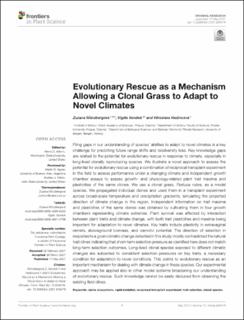| dc.contributor.author | Münzbergová, Zuzana | |
| dc.contributor.author | Vandvik, Vigdis | |
| dc.contributor.author | Hadincová, Věroslava | |
| dc.date.accessioned | 2022-04-06T08:05:14Z | |
| dc.date.available | 2022-04-06T08:05:14Z | |
| dc.date.created | 2021-09-07T16:17:41Z | |
| dc.date.issued | 2021 | |
| dc.identifier.issn | 1664-462X | |
| dc.identifier.uri | https://hdl.handle.net/11250/2990078 | |
| dc.description.abstract | Filing gaps in our understanding of species' abilities to adapt to novel climates is a key challenge for predicting future range shifts and biodiversity loss. Key knowledge gaps are related to the potential for evolutionary rescue in response to climate, especially in long-lived clonally reproducing species. We illustrate a novel approach to assess the potential for evolutionary rescue using a combination of reciprocal transplant experiment in the field to assess performance under a changing climate and independent growth chamber assays to assess growth- and physiology-related plant trait maxima and plasticities of the same clones. We use a clonal grass, Festuca rubra, as a model species. We propagated individual clones and used them in a transplant experiment across broad-scale temperature and precipitation gradients, simulating the projected direction of climate change in the region. Independent information on trait maxima and plasticities of the same clones was obtained by cultivating them in four growth chambers representing climate extremes. Plant survival was affected by interaction between plant traits and climate change, with both trait plasticities and maxima being important for adaptation to novel climates. Key traits include plasticity in extravaginal ramets, aboveground biomass, and osmotic potential. The direction of selection in response to a given climatic change detected in this study mostly contradicted the natural trait clines indicating that short-term selection pressure as identified here does not match long-term selection outcomes. Long-lived clonal species exposed to different climatic changes are subjected to consistent selection pressures on key traits, a necessary condition for adaptation to novel conditions. This points to evolutionary rescue as an important mechanism for dealing with climate change in these species. Our experimental approach may be applied also in other model systems broadening our understanding of evolutionary rescue. Such knowledge cannot be easily deduced from observing the existing field clines. | en_US |
| dc.language.iso | eng | en_US |
| dc.publisher | Frontiers | en_US |
| dc.rights | Navngivelse 4.0 Internasjonal | * |
| dc.rights.uri | http://creativecommons.org/licenses/by/4.0/deed.no | * |
| dc.title | Evolutionary rescue as a mechanism allowing a clonal grass to adapt to novel climates | en_US |
| dc.type | Journal article | en_US |
| dc.type | Peer reviewed | en_US |
| dc.description.version | publishedVersion | en_US |
| dc.rights.holder | Copyright 2021 The Author(s) | en_US |
| dc.source.articlenumber | 659479 | en_US |
| cristin.ispublished | true | |
| cristin.fulltext | original | |
| cristin.qualitycode | 2 | |
| dc.identifier.doi | 10.3389/fpls.2021.659479 | |
| dc.identifier.cristin | 1932151 | |
| dc.source.journal | Frontiers in Plant Science | en_US |
| dc.relation.project | Norges forskningsråd: 274712 | en_US |
| dc.identifier.citation | Frontiers in Plant Science. 2021, 12, 659479. | en_US |
| dc.source.volume | 12 | en_US |

